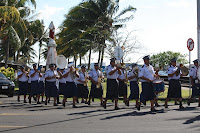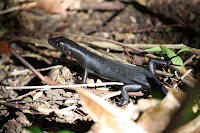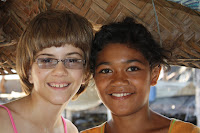Samoa is between longitudes 171º and 172º West and latitudes 13º and 14º South. It is comprised of eight small islands and two relatively large islands - Upolu and Savai'i - with the two larger islands comprising 96% of the total land area. The islands are volcanic and dominated by rugged mountain ranges reaching 6,094 feet on Savai'i and 3,608 feet on Upolu. The islands have fringing coral reefs and some lagoons.
Although Savai'i is the largest island, Upolu is the most developed and the island we visited first. The capital of Western Samoa, Apia, is on Upolu. Apia has a population of over 35,000, and it is the government base, business commercial center, and main port for the nation.
Western Samoa's population is approximately 175,000. Western Samoans are the most populous full-blooded Polynesian race in the world. Samoan is the national language, but English is the official language of business. Most Samoans are competent in English.
Western Samoa is a traditional society with a distinctive Polynesian cultural heritage. There are at least 362 villages in Western Samoa. Villages are made up of land owned by the aiga (extended family units), and each aiga is headed by a matai (chief). Matai may be male or female. Traditional authority is vested in the matai of the village, and there are an estimated 18,000 matai in Western Samoa. The central structures in each village are the church and the Fale Fono - a structure where the matais meet to discuss village matters.
The Western Samoan economy is mainly agricultural. They grow coconuts and bananas; however, their production of both is declining.
The harbor in Apia, the only official entry/exit port in Western Samoa, is well-marked and welcoming. They direct all boats to a new marina where we tied up and connected to the power and water. They promised free A/C transformers but they were already taken by the other American Boats. We hooked up the transformer we bought in Papeete and soon had the A/Cs cooling. We ran the A/Cs every night and then charged up batteries during the day. Our transformer would only handle one load or the other but it worked really well. We enjoyed dirty looks from several other boats that had no way to connect to the 220 volt power. The officials are pleasant and efficient, and checking in was relatively quick since they came right to the boat.
The open-air food and craft market is inland a few blocks. There one can find whatever fresh fruits and vegetables are locally grown and a slice of local life. Most sellers and shoppers in the marketplace are women, and many men spend their time in the kava corner. The corner is a small area lined with benches where men can sit around and drink kava. Kava is a root that is ground and soaked in water to make a drink that will numb the lips. Sorry, no women allowed.
Getting around the rest of Apia was convenient by walking. They have a public bus system here too. The buses were colorful and personalized somewhat like in American Samoa, but these buses were subdued in comparison. We took a bus one day to see a fresh water pond that was right next to the sea.
 | |
| Samoan lawn mowers |
We walked along the road with Dirk and Ann and saw lovely churches and fresh water pools right by the salt water sea. Each bus stop had large stalks of bananas and the local told us that they were free for the children and also visitors. We saw several of the village women gathering for discussions. They all had on the same outfits and were thrilled we took their picture.
We visited Robert Louis Stevenson's home and toured the extensive grounds. We hiked to the top of the hill where we saw his final resting place and beautiful views.
Another popular male activity here was rowing canoes. The canoes are huge - we counted 44 men rowing plus one steering and one drumming. We actually saw a woman steering one canoe, but we never saw any rowing. And they do have someone drumming on board. Forty two of the men sit two abreast, and they use both hands/arms on one oar. We were surprised that they use large oars rather than paddles. They move fast, and we were told that they participate in open ocean competitions.
We did make it out to Aggie Greys hotel to watch some local dancing one night. The women dance a form of hula that is quite different from Hawaiian hula and completely different from the high energy hula in French Polynesia. In fact, they don't use their feet much at all, and they are often sitting on the ground. They use constant hand gestures and subtle facial expressions. It is quite nice to watch. The men, on the other hand, are extremely physical and aggressive slapping both chest and legs. There is nothing subtle about the way they dance. We have been told that this male dancing is tame in comparison to the New Zealand Maoris, but this was energetic and aggressive enough for us.
We met Dirk and Ann on Sail Away who hail from Canada and are going around for a second time. They had met a family 13 years ago in Savaii and we were invited to tag along for the reunion. We sailed west to the anchorage of Matautu Bay and arrived a day before them. We all attended church on Sunday and were invited to share lunch with them in their home. The singing in the service was really special and all the men and women wore white shirts and dresses.
The family's house and fale were built right on a lava flow that occurred when the volcano last erupted in 1911. We removed our shoes and were given a woven mat to sit on and were brought our food first as honoured guests. The grandfather had stayed home and prepared the meal while we were in church. We were served chicken soup with noodles, taro root and clams in coconut milk. They even served us the cakes that we had made for them. They would sit and fan away any flies from the food while we ate. Only after we had finished and swore that we could eat no more were the others served.
After everyone had eaten, Dirk and the father, Vaitai, went out in the car to bring back some ice cream. All they could find was a 4 gallon tub of coffee ice cream. Since the family has no refrigeration, there was a lot of gluttonous eating going on. After watching some of the family eating 3 large bowls, it was nice to see them bringing it and left-over cake to their neighbors to share.
Emily enjoyed playing with the many children and showed them how to fold origami animals, play hopscotch, and make a blade of grass into a whistle. Emily brought several stuffed animals as gifts, and we left some old clothes and Kim even baked a small cake. They showed us more of the lava field and several houses and churches that were destroyed. We saw one spot where the lava had stopped and had flowed completely around the grave of a small girl. They call it the Virgin's Grave and visitors regularly leave flowers there.
The next day we were driven by Vaitai to Salelologa where I bought a hand carved kava bowl. I had seen them in Apia but did not buy one. These are large bowls in which the kava juice is made and served. The carving is quite good and I bought one that is about 6" high and 15" in diameter with about 20 round legs. After buying the bowl, I paid 2 tala for Vaitai and me to sit and try my first kava. I drank one cup (half of a coconut shell) full. You drink the entire cup in one motion without stopping. I had heard that it tasted horrible, but it was not bad at all. After about a minute, my lips and tongue started to go numb. Vaitai drank 3 cups before we headed back to the boat. I was anxious to try kava, since it will be required that I present each village chief in Fiji with kava root to gain permission to anchor near their village. Many times, the captain is invited to attend a formal kava ceremony where it would be an insult not to drink.
But I get ahead of myself, Dear reader. I need to go to the Kingdom of Tonga first. Tomorrow, we will head there. Since Tonga is across the date line, I will also loose an entire day(24 hours) during the 180 mile passage. I hope you will come along with us.
Tom



















































4 comments:
Safe journey, I look forward to the next installment
The farther away you get from the USA the fewer update we are getting, keep posting on shiptrak and add a note along with the position at least we know your still afloat.
You had better send that bowl to me for safe keeping. I'll try it out for you.
love Mom
I enjoy reading your blog and check in frequently to see where you guys are located. Thanks for all the of interesting facts about the places that you visit.
Great to see your are having a wonder ful time. I can't believe how tall Emily has gotten. I hope your keeping
track. Chris
Post a Comment